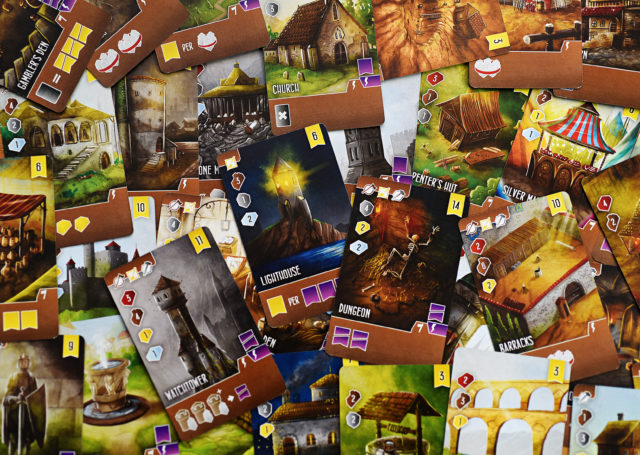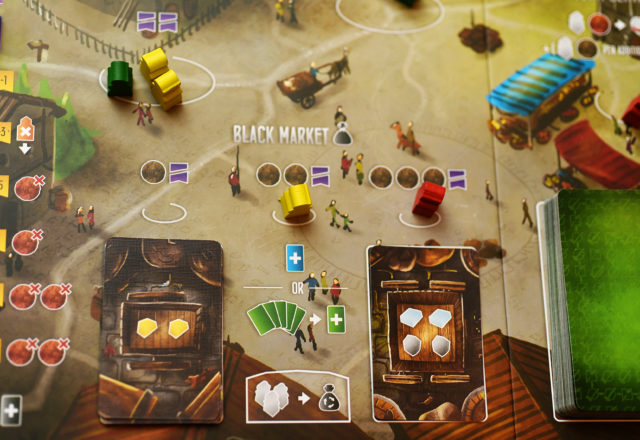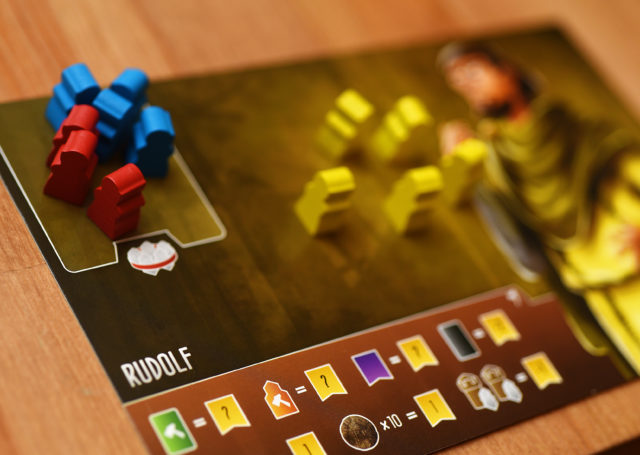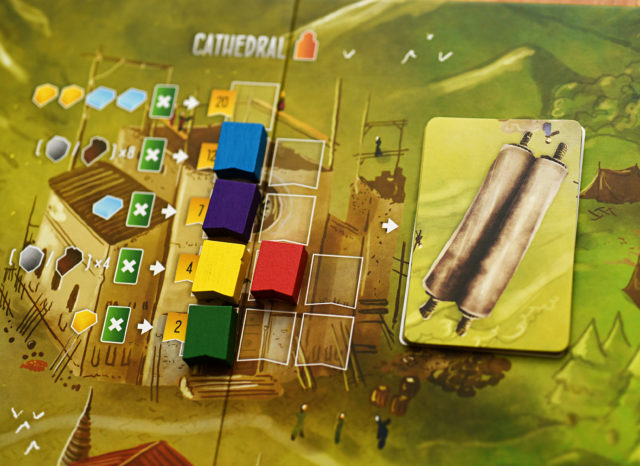I am new to the games of Shem Phillips. Architects of the West Kingdom is the first of his that I’ve had a chance to play. Having missed out on often compared titles like Raiders, Shipwrights, and Explorers of the North Sea make me less capable of making those comparisons myself. However, that might actually be perfect. It allows me to approach Architects with totally fresh eyes and review only the game in front of me.
In Architects of the West Kingdom, you play, as you can guess, an architect. The setting is the newly settled region of Carolinga in 850 AD. You and your team of workers set out to construct the buildings that will turn the area into a thriving metropolis, while joining forces to build the church as well.

Architects is not played in rounds, rather the turns just rotate until the game end trigger has been met. This game feels like an old school worker placement game. I send a worker here, I get this benefit. But there are some interesting added elements which make it unique. Honestly, I’m a fan of worker placement games anyway (see the name of this blog), so it was likely I would enjoy it.
You start off with 20 workers eager to do your bidding, three Building cards that you’ll draft for, and three or more coins depending on your starting position. You’ll also all start with seven Virtue on that track, which you might climb or fall on. Note: these are the starting conditions for the standard game. I highly recommend after your first play, going to the advanced rules, where each player will start asymmetrically.
Once the game begins, you’ll take turns playing workers out to the different locations in town in an effort to complete your goals.
There are locations to get resources like Clay, Wood, Stone, Silver, and Gold. These spots on the board can hold as many workers as the players want to send there. The more workers of your colour in a location, the more resources you’re going to earn. So, there is some incentive to continue to visit the same place, but there is a risk in that too. We’re getting there.

Visiting the King’s Storehouse allows you to trade in resources for some other benefit. You can raise yourself up on the Virtue track, or get your hands on the most valuable resource, Marble. Again, although you deploy only one worker a turn, you can have several at the Storehouse at a time and can perform actions equal to the amount of workers you have there.
The Workshop allows you to get more Building cards, or more likely you’ll go there to hire an Apprentice. At any time there are eight Apprentice cards available. There are townsfolk that help you out in one way or another. Some grant you an immediate bonus, others will improve your actions when you visit certain locations. Each of the Apprentices also have one or more skills which may be a requirement for constructing certain buildings. The more workers you have at the Workshop, the more Apprentices become available to you.
Throughout the game you’re going to have to pay money for certain things, and while some of it goes to the bank, other payments are paid to the Tax Stand. It starts the game with four coins and that will grow every time tax is paid. The pot will start to get pretty big and you can rob the Tax Stand for all the coins there. It will, however, cost you two steps on the Virtue track.

The Town Center is where things start to get really interesting. Here, you can bribe some local officials to round up the workers of one or two of your opponents. You choose one location and take all of one player’s workers hostage onto your board. This is where grouping a lot of your workers in one place becomes risky. It’s a target for them to get rounded up. While they’re on your opponent’s board, it’s not a huge threat, but they are out of your rotation and what was once a powerful location to send workers now has no one. The real problems begin if your workers get sent to…
The Guardhouse is a place where a lot of different actions can be taken depending on the amount of workers you have there. You can send all of the opposition workers you have taken hostage to jail, gaining a Silver for each one. You can also spring any of your workers cooling their heels in the slammer, break your workers free from an opponent holding them hostage, or get rid of a debt card. Debt cards are taken for different reasons in the game, but they will cost you two points at the end of the game if you still have them.

When going the legit route to build up the city loses its appeal, you can always take a shortcut. The Black Market offers three single use spaces. There is a small reward space with usually some rare resources, and a large reward with even more rare resources. In between there is a place to gain more Building cards or Apprentices at a bargain. Each space will cost you some Silver and a space on the Virtue track, but it can be a quick way to get a boost in the game. When the third space of the Black Market has been filled, it triggers a round up. All the workers in the Black Market spaces are sent to the Guardhouse and then some additional punishment is doled out. Anyone who has three or more workers in the Guardhouse loses a space on the Virtue track and the person with the most incarcerated workers gains a Debt card. Nasty business!
The final location you can send a worker is the Guildhall. This is how you construct buildings and help build the Church, and it also works as the timer for the game. Buildings have an end game point value and sometimes an in-game benefit. When you contribute to the Church, you move up a level and get a Reward card. Each worker in the Guildhall is laid flat and brings the game closer to its end. Once the Guildhall is filled, each player gets one more turn. This starts off slow, but can really pick up near the end of the game, so watch out for it.

At game end, you’ll receive points for the Buildings you’ve made, your level on the Church, your space on the Virtue track, each Gold or Marble resource is worth a point, and each 10 Silver is worth a point. You’ll lose points for unpaid Debt cards and every two workers in prison.
Throughout the game, you’ll move up and down the Virtue track for actions that you take. This affects your end game score, but it can also have an impact on you during the game. If you drop too far down the track, you won’t be able to make contributions to the Church. Your dirty money will be no good there. However, become too virtuous and you’ll lose the ability to visit the Black Market. People of high honour would never venture to that part of town.
I quite enjoyed Architects. It is a really straight forward worker placement game that I’ve found easy to teach to people, but with lots of different strategies to employ. I think that people new to gaming will easily be able to pick up the rules and be constructing the new town in no time.

I like that there is both a reward and a risk for returning to the same place over and over again. You get a better return on your investment each time you go, but become a bigger target for your opponents to round up your workers. That makes for an interesting dynamic. Not having played any of the other games in this series, I can’t compare this one. I can only reference it on the game itself, but I’ve really enjoyed my plays.
Architects of the West Kingdom is a competitive game for 1 to 5 players. It was designed by Shem Phillips and SJ Macdonald, featuring art by Mihajlo Dimitrievski. A review copy was generously provided by Renegade Games for this article.
Really like this one too. If you are going to try more in this series, give Raiders of the North Sea and Explorers of the North Sea a look first. Good on their own but great with the Expansions
Hello, good time , which game do you think is better?
Architects of the West Kingdom
Or
Paladins of the West Kingdom
Tnx
In my humble opinion, Paladins is better–I just like the mixture of mechanics more than with Architects, and I think the solo mode is more interesting and challenging. However, I know people who feel the other way!